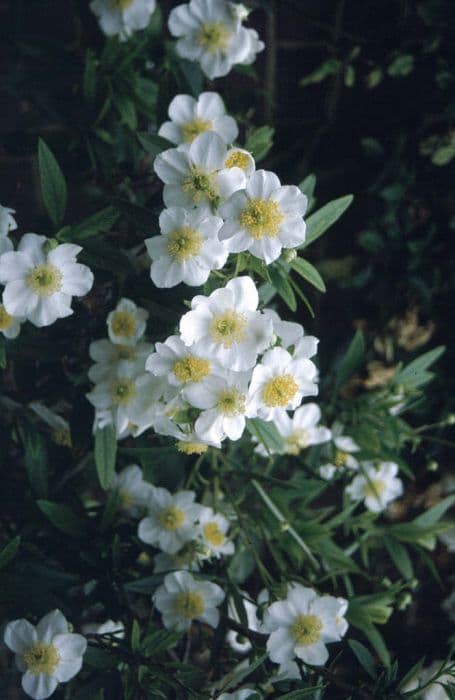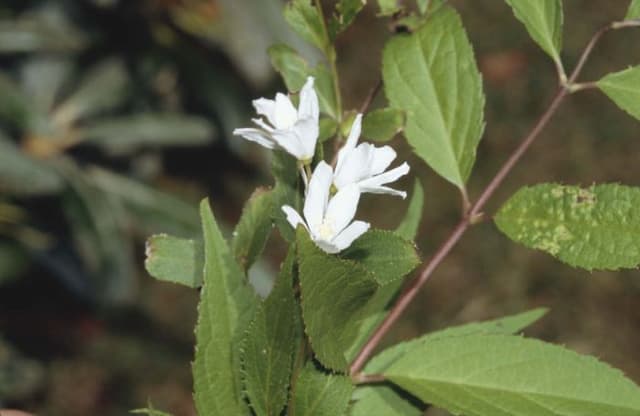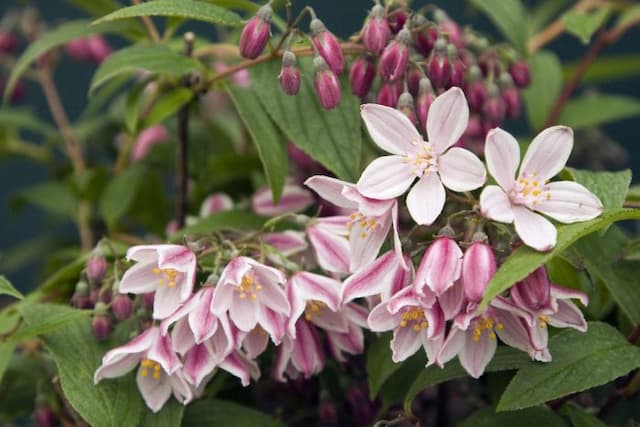Hydrangea Hydrangea Miss Saori = 'H2002' (PBR) (d)
![hydrangea [Miss Saori]](/_next/image?url=https%3A%2F%2Fplants-admin.emdemapps.com%2Fimages%2Fplants%2F%2Fimages%2F604b642a3ee9f.png&w=3840&q=75)
ABOUT
The Hydrangea Miss Saori features stunning double flowers with a unique color pattern. Each of the blooms showcases a captivating two-tone effect, marrying a creamy white color with soft pink edges that give it a delicate, painterly appearance. The heart of the flower sports deeper pink hues that highlight the eye-catching contrast of colors on the broad, rounded petals. These blossoms cluster together to form large, conspicuous globes that attract the eye and create a rich tapestry of color. Adding to its charm, the flowers stand against a backdrop of lush, deep green leaves that provide a dense foil for the lighter floral tones. The leaves themselves have a broad, slightly serrated edge, which further emphasizes the plant's full-bodied texture. As the seasons change, the flowers of the Hydrangea Miss Saori may undergo a subtle shift in color, reflecting the changing environmental conditions and infusing the plant with a dynamic quality that evolves through its blooming period.
About this plant
 Names
NamesFamily
Hydrangeaceae
Synonyms
Miss Saori Hydrangea, Wedding Gown Hydrangea
Common names
Hydrangea macrophylla 'H2002' Miss Saori.
 Toxicity
ToxicityTo humans
The Hydrangea is commonly recognized as potentially toxic to humans. The plant contains compounds called cyanogenic glycosides, which can release cyanide when ingested. If parts of the Hydrangea are ingested by humans, symptoms of poisoning may include nausea, vomiting, stomach pain, and diarrhea. In severe cases, dizziness, fainting, and respiratory issues may occur due to the cyanide's interference with oxygen utilization in the body. It is important for humans to avoid ingestion of any part of the Hydrangea plant.
To pets
Hydrangea is also toxic to pets, including dogs and cats. Similar to humans, the toxicity arises from cyanogenic glycosides found within the plant's leaves and flower buds, which can release cyanide into the pet's body when ingested. Symptoms of poisoning in pets may include vomiting, diarrhea, lethargy, depression, and in severe cases, confusion, cardiovascular collapse, hyperventilation, and potentially coma. Pet owners should ensure that pets do not have access to chew or ingest any parts of the Hydrangea plant.
 Characteristics
CharacteristicsLife cycle
Perennials
Foliage type
Deciduous
Color of leaves
Green
Flower color
Mixed
Height
3-4 feet (91-122 cm)
Spread
3-4 feet (91-122 cm)
Plant type
Shrub
Hardiness zones
5
Native area
Asia
Benefits
 General Benefits
General Benefits- Award-Winning Beauty: Hydrangea Miss Saori was awarded the coveted RHS Chelsea Flower Show Plant of the Year in 2014, highlighting its exceptional beauty.
- Unique Flowers: The plant features stunning double flowers with a two-toned color pattern—white with a pink edge—which adds a mesmerizing charm to gardens and landscapes.
- Prolonged Blooming Period: It blooms from early summer to late fall, providing a long season of visual interest.
- Deciduous Shrub: As a deciduous shrub, it contributes to the yearly cycle of seasonal change in a garden, with foliage that changes color in fall.
- Versatile Use: Hydrangea Miss Saori can be used in perennial borders, as a specimen plant, or as part of a shrub border, offering a lot of flexibility in garden design.
- Attracts Pollinators: The flowers attract bees and butterflies, promoting biodiversity and benefiting the local ecosystem.
- Cold Hardy: It's relatively cold-hardy (USDA Zones 5-9), making it suitable for a variety of climates.
- Easy to Care: Generally low maintenance, requiring minimal pruning and care, making it ideal for both experienced and novice gardeners.
- Adaptable to Soils: Hydrangea Miss Saori adapts well to various soil types, though it prefers moist, well-drained soil.
- Great for Cut Flowers: The blooms make excellent cut flowers for vases and floral arrangements, lasting well once cut.
 Medical Properties
Medical PropertiesThis plant is not used for medical purposes.
 Air-purifying Qualities
Air-purifying QualitiesThis plant is not specifically known for air purifying qualities.
 Other Uses
Other Uses- Art and Craft Supplies: The dried, colorful petals of Hydrangea Miss Saori can be used for making bookmarks, greeting cards, or for inclusion in resin art pieces.
- Edible Decorations: Although the plant is not widely known for being edible, the petals can occasionally be used for decorative purposes on elaborate desserts in high-end cuisine, but they should not be consumed regularly.
- Hydrangea Watercolor: The intense colors of Hydrangea Miss Saori flowers can be used to create natural watercolor dyes for artistic painting.
- Photography Prop: The beautiful flowers can serve as a perfect backdrop for spring and summer themed photography sessions.
- Pressed Flower Art: Flowers from the Hydrangea Miss Saori can be pressed and used to create framed botanical artwork.
- Fabric Dyeing: The flowers may be used in the process of natural fabric dyeing to give textiles a unique, soft hue.
- Theme Gardens: This plant can be used to create a "Miss Saori"-themed garden, showcasing this and other award-winning or unique hydrangea varieties.
- Color Themed Flower Arrangements: Use the flowers to create a pink and white themed bouquet, aligning with wedding décor or other themed events.
- Screenprinting: The outline or pattern of the Hydrangea Miss Saori leaves and flowers can be used in the design for screenprinting on fabric or paper.
- Fairy Gardens: Incorporate the Hydrangea Miss Saori into miniature fairy gardens for an attractive aesthetic due to their unique double-flowering nature and attractive foliage.
Interesting Facts
 Feng Shui
Feng ShuiThe Hydrangea is not used in Feng Shui practice.
 Zodiac Sign Compitability
Zodiac Sign CompitabilityThe Hydrangea is not used in astrology practice.
 Plant Symbolism
Plant Symbolism- Heartfelt Emotions: Hydrangeas generally symbolize deep and sincere emotions due to their lush appearance and the generous number of flowers they produce.
- Gratitude: The abundant and long-lasting blooms of the hydrangea often represent appreciation and thanksgiving, making them a common gift to express gratitude.
- Understanding: Hydrangeas can reflect a deep understanding between people, due to the complexity and density of the flower heads.
- Apology: In some cases, hydrangeas can symbolize an apology, expressing a desire for forgiveness with their lush and appealing flowers.
- Boastfulness (and/or) Vanity: Some historical narratives assign a less positive meaning to hydrangeas, seeing the plant's grandiose blooms as a symbol of arrogance or self-absorption.
- Fourth Anniversary: Hydrangeas are often used to represent the fourth wedding anniversary, symbolizing appreciation and enduring dedication in marriage.
 Water
WaterThe Hydrangea Miss Saori prefers consistently moist soil, so water thoroughly whenever the top inch of soil feels dry to the touch. This typically means watering once or twice a week, but this can vary depending on climate and weather conditions. Use a gentle stream to soak the soil around the plant, avoiding overhead watering to prevent leaf diseases. Each watering session should involve approximately 1 to 1.5 gallons of water, ensuring even hydration of the root zone. During hot or windy weather, you may need to water more frequently to maintain soil moisture levels.
 Light
LightHydrangea Miss Saori thrives best in partial shade to full sun conditions. An ideal spot for this plant would be one where it gets morning sunlight and afternoon shade, especially in hotter climates. Protection from the intense afternoon sun will help to keep the blooms vibrant and prevent scorching of the leaves.
 Temperature
TemperatureThe ideal temperature range for Hydrangea Miss Saori is between 65°F to 75°F, but it can tolerate temperatures as low as 50°F and as high as 80°F. It is important to protect the plant from frost and extreme cold, which can damage the foliage and blooms. The Hydrangea Miss Saori is generally hardy in zones 5 through 9.
 Pruning
PruningPruning Hydrangea Miss Saori enhances its shape and encourages new growth and blooms. It's best to prune just after the flowers fade in late summer or early fall, cutting back the stems that have bloomed by about one-third. Prune out any damaged or crossing stems to maintain good air circulation, being careful not to over-prune as it may bloom on old wood.
 Cleaning
CleaningAs needed
 Soil
SoilHydrangea Miss Saori thrives best in a well-draining, rich, loamy soil with a pH of about 5.5 to 6.5. A good soil mix would include garden soil, compost, peat moss, and perlite at a ratio of 2:2:1:1 to ensure moisture retention and aeration.
 Repotting
RepottingThe Hydrangea Miss Saori should be repotted every 2-3 years, or when it outgrows its current pot. Larger specimens may be repotted less frequently, as long as the soil is refreshed and roots are pruned if needed.
 Humidity & Misting
Humidity & MistingHydrangea Miss Saori prefers moderate to high humidity levels. Providing a humidity level of 50-60% is ideal for maintaining the health of the plant.
 Suitable locations
Suitable locationsIndoor
Place in bright, indirect light and maintain humidity.
Outdoor
Plant in morning sun, dappled shade, and protect from hot afternoon rays.
Hardiness zone
5-9 USDA
 Life cycle
Life cycleThe Hydrangea Miss Saori, also known simply as Hydrangea, begins its life cycle with seed germination, although commercially it's often propagated via cuttings. After rooting, the young plant enters a vegetative growth phase where it develops a robust root system and foliage. In spring and early summer, it transitions to the flowering stage, producing distinctive double flowers with a pink or white color edged with red, which bloom from early summer to fall. Post-blooming, the plant undergoes a period of seed development, though most propagation is vegetative rather than through these seeds. As autumn approaches, the Hydrangea enters a dormancy period, with leaves turning yellow and dropping as the plant conserves energy for the winter. When warmer temperatures return in spring, the cycle begins anew with new vegetative growth, preparing the plant for another flowering season.
 Propogation
PropogationPropogation time
Spring-Early Summer
The most popular method of propagating Hydrangea Miss Saori is by taking softwood cuttings in early summer when the plant's new growth is still flexible and not yet mature. To propagate, select a healthy stem with several leaves and cut it just below a leaf node, typically 4 to 6 inches (about 10 to 15 centimeters) in length. Remove the lower leaves to expose the nodes and possibly dip the cut end into rooting hormone powder to encourage root development. The cutting can then be inserted into a pot filled with a mix of peat and perlite or a similar well-draining rooting medium. It is then crucial to maintain high humidity around the cutting, often by covering the pot with a plastic bag or placing it in a propagator, and to keep it in indirect sunlight. Roots typically develop within a few weeks, after which the new hydrangea plant can eventually be transplanted outdoors.








![Hydrangea [Strong Annabelle]](/_next/image?url=https%3A%2F%2Fplants-admin.emdemapps.com%2Fimages%2Fplants%2F%2Fimages%2F604b54db37d34.png&w=640&q=75)
